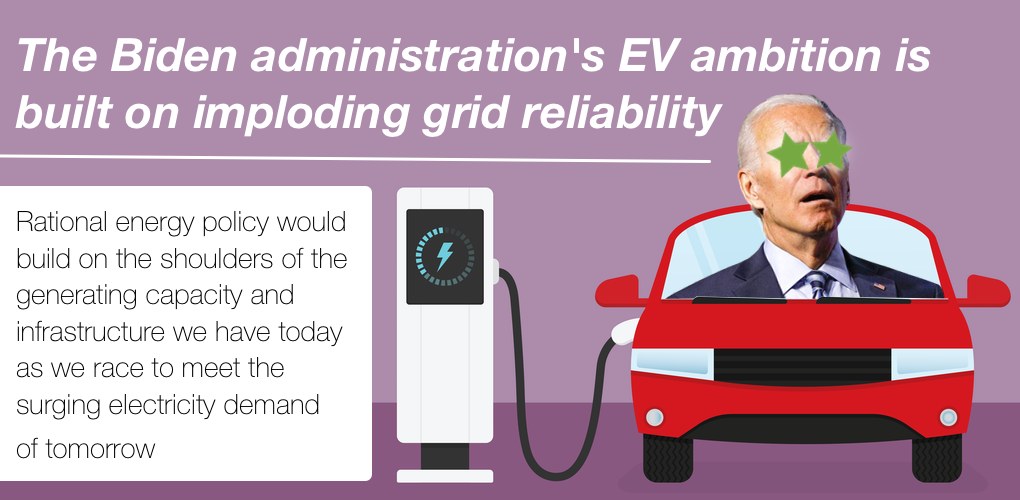
EV Ambitions Built on Imploding Grid Reliability
The Biden administration seems perpetually optimistic, and rarely realistic. The U.S. Environmental Protection Agency (EPA) has rolled out new tailpipe emission standards that are going to force a lightning-quick pivot to electric vehicles (EVs). By 2032, EPA hopes that 67% of new car sales are zero-emission. Getting there is going to be colossally challenging. It’s not like threading the eye of a needle—it’s more like doing it a dozen times simultaneously. From the buildout of charging infrastructure and mineral supply chains to, not least of all, a rapid expansion of the nation’s electricity grid and generating capacity, an extraordinary amount must fall in place exactly as EPA hopes.
A slip up with anyone of these pieces could derail the administration’s ambitions, but, as The Washington Post observed, the health of the nation’s electricity grid might be the elephant in the room: “The initiative is being launched at the same time the nation’s electricity grid — which would fuel all these new EVs — is wheezing, with destabilizing power outages and developers of wind and solar projects often stuck waiting years to connect to transmission lines.”
EPA, not surprisingly, has concluded that the addition of millions of EVs will not place a significant new burden on the grid. EPA’s flippant analysis follows a familiar pattern: analyze their rulemakings in isolation detached from larger trends and using the most advantageous modeling possible.
EPA may be conveniently pretending otherwise but the electrification of transportation is, of course, just one piece of the electrification revolution now well underway. EVs, heat pumps, induction stoves and the electrification of heavy industry are all placing an enormous new burden on the grid and will require a rapid expansion of transmission infrastructure and generating capacity. The National Renewable Energy Laboratory projects that meeting this electrified future will require a doubling of generation capacity in all regions of the country by 2050.
That doubling of generation capacity simply isn’t happening. In fact, EPA is working diligently to take apart existing capacity far faster than replacement capacity is coming online. EPA’s regulatory blitz of rulemakings aimed at the coal fleet is poised to push the nation’s grid reliability backstop all but off the grid in the same decade that millions of EVs, heat pumps and countless data centers drive power demand relentlessly upwards.
On-The-Ground Reality
The nation’s largest grid operator, PJM, has illustrated how this is playing out. PJM projects that it will lose 40 GW of generating capacity by 2030 – enough to power 30 million homes – with only 31 GW of additions in the same period. EPA’s regulatory onslaught is opening a massive gap grid operators, utilities and energy regulators are increasingly at a loss to fill.
California, already a few steps ahead of the rest of the country in the pivot to EVs, is a cautionary tale as well. Last summer, California mandated that 35% of new car sales in 2026 need to be zero-emissions, ramping up to 100% by 2035. The state found that powering these vehicles and electrifying other sectors of the economy will require a tripling – not a doubling – of power generating capacity and the addition of wind and solar resources at five times the pace achieved in the prior decade. Just six days after the state enacted the new mandate, the grid was so stressed by a heat wave that a 10-day emergency alert went out begging residents to cut power use – including EV charging – to stave off rolling blackouts.
Even Norway, the world-leader in EV adoption with 80% of new car sales electric, is facing immense challenges in keeping up with power demand. Electrification of transportation and industry has the nation’s grid operator, Statnett, projecting a power shortfall by 2027. Just in the last four years, Statnett has received requests for grid connections that equate to a doubling of the nation’s power demand.
Whether or not EPA wants to face the challenges of electrification, they are very real and only growing because of EPA’s own agenda. As the nation’s grid regulators and grid operators have made clear, the reliability of our power supply is in trouble, and shifting energy demand from transportation, heating and a litany of other industrial end uses onto the shoulders of the grid is making the stakes that much higher.
Rational energy policy would build on the shoulders of the generating capacity and infrastructure we have today as we race to meet the surging electricity demand of tomorrow. But nothing about what EPA is doing is rational or grounded in an honest assessment of what’s needed to manage the transition ahead.
- On April 19, 2023
